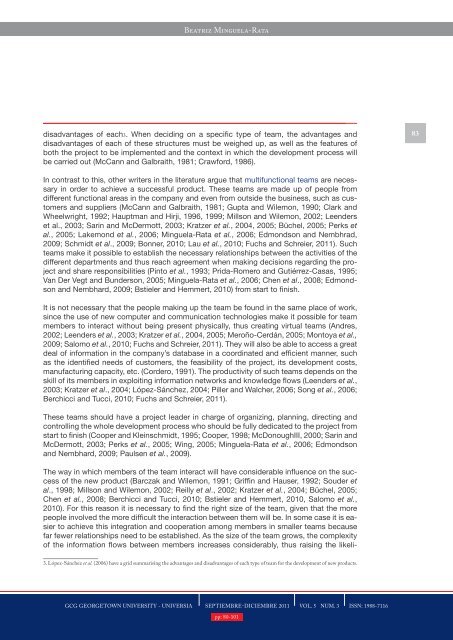Vol. 5 Num. 3 - GCG: Revista de Globalización, Competitividad y ...
Vol. 5 Num. 3 - GCG: Revista de Globalización, Competitividad y ...
Vol. 5 Num. 3 - GCG: Revista de Globalización, Competitividad y ...
- No tags were found...
Create successful ePaper yourself
Turn your PDF publications into a flip-book with our unique Google optimized e-Paper software.
Beatriz Minguela-Ratadisadvantages of each3. When <strong>de</strong>ciding on a specific type of team, the advantages anddisadvantages of each of these structures must be weighed up, as well as the features ofboth the project to be implemented and the context in which the <strong>de</strong>velopment process willbe carried out (McCann and Galbraith, 1981; Crawford, 1986).83In contrast to this, other writers in the literature argue that multifunctional teams are necessaryin or<strong>de</strong>r to achieve a successful product. These teams are ma<strong>de</strong> up of people fromdifferent functional areas in the company and even from outsi<strong>de</strong> the business, such as customersand suppliers (McCann and Galbraith, 1981; Gupta and Wilemon, 1990; Clark andWheelwright, 1992; Hauptman and Hirji, 1996, 1999; Millson and Wilemon, 2002; Leen<strong>de</strong>rset al., 2003; Sarin and McDermott, 2003; Kratzer et al., 2004, 2005; Büchel, 2005; Perks etal., 2005; Lakemond et al., 2006; Minguela-Rata et al., 2006; Edmondson and Nembhrad,2009; Schmidt et al., 2009; Bonner, 2010; Lau et al., 2010; Fuchs and Schreier, 2011). Suchteams make it possible to establish the necessary relationships between the activities of thedifferent <strong>de</strong>partments and thus reach agreement when making <strong>de</strong>cisions regarding the projectand share responsibilities (Pinto et al., 1993; Prida-Romero and Gutiérrez-Casas, 1995;Van Der Vegt and Bun<strong>de</strong>rson, 2005; Minguela-Rata et al., 2006; Chen et al., 2008; Edmondsonand Nembhard, 2009; Bstieler and Hemmert, 2010) from start to finish.It is not necessary that the people making up the team be found in the same place of work,since the use of new computer and communication technologies make it possible for teammembers to interact without being present physically, thus creating virtual teams (Andres,2002; Leen<strong>de</strong>rs et al., 2003; Kratzer et al., 2004, 2005; Meroño-Cerdán, 2005; Montoya et al.,2009; Salomo et al., 2010; Fuchs and Schreier, 2011). They will also be able to access a great<strong>de</strong>al of information in the company’s database in a coordinated and efficient manner, suchas the i<strong>de</strong>ntified needs of customers, the feasibility of the project, its <strong>de</strong>velopment costs,manufacturing capacity, etc. (Cor<strong>de</strong>ro, 1991). The productivity of such teams <strong>de</strong>pends on theskill of its members in exploiting information networks and knowledge flows (Leen<strong>de</strong>rs et al.,2003; Kratzer et al., 2004; López-Sánchez, 2004; Piller and Walcher, 2006; Song et al., 2006;Berchicci and Tucci, 2010; Fuchs and Schreier, 2011).These teams should have a project lea<strong>de</strong>r in charge of organizing, planning, directing andcontrolling the whole <strong>de</strong>velopment process who should be fully <strong>de</strong>dicated to the project fromstart to finish (Cooper and Kleinschmidt, 1995; Cooper, 1998; McDonoughIII, 2000; Sarin andMcDermott, 2003; Perks et al., 2005; Wing, 2005; Minguela-Rata et al., 2006; Edmondsonand Nembhard, 2009; Paulsen et al., 2009).The way in which members of the team interact will have consi<strong>de</strong>rable influence on the successof the new product (Barczak and Wilemon, 1991; Griffin and Hauser, 1992; Sou<strong>de</strong>r etal., 1998; Millson and Wilemon, 2002; Reilly et al., 2002; Kratzer et al., 2004; Büchel, 2005;Chen et al., 2008; Berchicci and Tucci, 2010; Bstieler and Hemmert, 2010, Salomo et al.,2010). For this reason it is necessary to find the right size of the team, given that the morepeople involved the more difficult the interaction between them will be. In some case it is easierto achieve this integration and cooperation among members in smaller teams becausefar fewer relationships need to be established. As the size of the team grows, the complexityof the information flows between members increases consi<strong>de</strong>rably, thus raising the likeli-3. López-Sánchez et al. (2006) have a grid summarising the advantages and disadvantages of each type of team for the <strong>de</strong>velopment of new products.<strong>GCG</strong> GEORGETOWN UNIVERSITY - UNIVERSIA SEPTIEMBRE-DICIEMBRE 2011 VOL. 5 NUM. 3 ISSN: 1988-7116pp: 80-101















